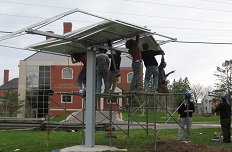
Colleges and universities consume huge amounts of energy. Many large campuses and research institutions are like mini-cities, using as much or more energy to function as a small city does. Reducing energy usage on campuses has become a top priority, not only to cut costs, but also to reduce campus carbon footprints.
For most institutions, the energy required for their buildings and other operations is by far the largest component of their carbon footprints. Many colleges are now requiring their buildings to be LEED-certified (Leadership in Energy and Environmental Design) or to meet other types of certifications in order to green their buildings.
What can you do as a student to reduce your campus carbon footprint?

Take personal steps to reduce your energy consumption, such as by shutting off lights and unplugging electronics when not in use.

Work with your facilities department, sustainability office and faculty to understand how buildings function and what can be done to decrease the amount of energy they use.

Get your campus to participate in the largest national energy and water reduction program for colleges and universities.Campus Conservation Nationals
Exciting trends are appearing at institutions across the country. Universities and colleges are increasing their use of renewable energy, setting strong energy reduction goals, improving building operations, increasing energy efficiency and even holding campus energy competitions. These actions are all contributing to reduce energy footprints.
Interested in pursuing a sustainable energy career? Check out the sustainable energy careers outlook in the EcoLeaders Career Center to learn more about careers in the field, hear from professionals, and map out your career plan.









